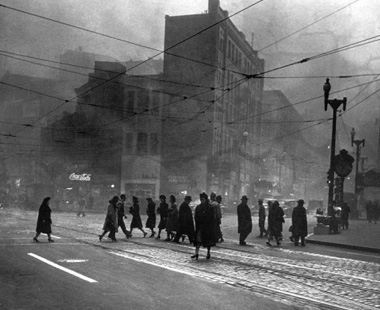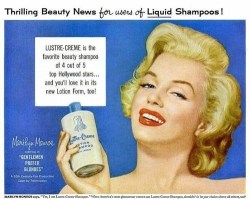Dear treehugging friends: If only you guys had an ounce of marketing savvy. You could have tuned me into a green practice, plus saved me years of too-flat, uninspiring hair, and buckets of cash to boot. I know some of you have been washing your hair with baking soda and finishing it with a vinegar rinse for years, yet the only pitch I’ve ever heard on this practice is a limp, “It’s good for the environment!” Well, next time, try this instead:
Want to know the secret to shiny, voluminous, all-around gorgeous hair? It’s a specially formulated treatment guaranteed to take your coif to entirely new levels of excellence. We’re talking cascading waves of Penelope Cruz-level excellence. Try the BSV Treatment — you’d pay upwards of $20 for it at a salon — and see for yourself.
That’s a little more like it, eh? If I’d heard that, I wouldn’t have brushed off the idea of baking soda-vinegaring my hair so easily. The reasoning is sound: desire to avoid the chemicals packed into everyday commercial toiletries*, reduce plastic-bottle purchases, and old-fashioned thriftiness. Still, to a populace raised on the importance of lather-rinse-repeat, it sounds weird. When an old friend from grad school mentioned over lunch that lately she’d been cleansing with nothing but the baking soda-vinegar combo, I thought, What a nut. What’s next, homemade lemon-juice deodorant? Except her hair did look pretty sleek and luxurious.
So when I ran across yet another reference to the BSV hair-care regimen in a book about ecologically friendly home practices, I knew I had to try it. Advocates swear that baking soda naturally strips oil, softens, and removes weird buildup from whatever other crap you’ve been putting in your hair. The vinegar rinse is credited with adding shine, detangling, and clarifying. I’ve already learned firsthand about the magic that good old sodium bicarbonate can work on your kitchen counter and laundry basket. Why not on my head, too?
Still, it was with some level of trepidation that I stepped into the shower a couple of weeks ago armed with a Tupperware dish of baking soda paste and some diluted apple cider vinegar in a cup. Just how bad would it make my fine hair look? Dull? Lifeless? Greasy? It didn’t really occur to me that it might actually work.
My research had uncovered several exotic-sounding shampoo recipes, some incorporating olive oil, honey, and coconut milk, but I’d decided to keep it simple to start. My shampoo was a concoction made of a tablespoon or so of baking soda and enough water to render it workable. For the conditioner, I’d mixed about a tablespoon of vinegar and a tablespoon of water. (Why apple cider vinegar over the usual stuff? No idea — but every reference I found to this practice stressed that the apple cider variety was The One.)
I turned on the water, took a deep breath, and poured the proto-shampoo over my head. Hmm. Unlike the usual pearlescent goop we’re all used to, the gritty paste doesn’t lather up into easy-to-distribute suds. I tentatively scrubbed it into my scalp, attempting to move the stuff throughout my hair and adding more water when it felt necessary. I rinsed, then felt a few strands. It didn’t really feel clean — what kind of scam was this?
Still, I pressed on to the vinegar rinse. This would be much easier to apply via spray bottle, but the only bottle I have was otherwise engaged holding a DIY all-purpose cleaner. So I tilted my head back and poured the cup’s contents over my head, trying (and only marginally succeeding) to keep it out of my eyes. The Easter-egg aroma was, uh, potent, but hey … it did seem to have a detangling effect.
I hopped out of the shower and toweled off, ready for the moment of truth. To avoid introducing variables to the process, I skipped all other hair products and let my mop air-dry. And after about 30 minutes … well, hey, would you look at that? My hair had dried with more body than normal, and had a certain sheen. It looked fine — no, better than fine. Could it actually look a touch better?
Intrigued, I continued the experiment. Baking soda advocates usually recommend that you use it every other day or even less, so I alternated between just-water rinses and my new paste-and-pour routine. I tried it after sweaty workouts. I put products in my hair post-BSV and styled it. I attempted a few days with daily treatments. No matter what, the emerging result was clear: My head actually looked better. More volume, easier to style, manageable waves.
Like a high school sophomore reading Camus for the first time, I felt like my eyes had been opened to a startling new reality. Why oh why had I let myself be fleeced by the military-industrial-shampoo complex for so many years? Treachery, thy name is Herbal Essences!
Not quite ready to accept my own success, I badgered friends and family to try it, too. Would this miracle work for styles and textures different from my own? My mom, who rocks a casual bob, reported: “It’s like a clarifying rinse that strips all the gunk out of your hair.” My friend Tinaz, who gamely tried it on her enviably thick mane, said, “My hair looks and feels the exact same as when I use my usual Pantene Pro-Chemicals — and the vinegar was a treat for my shower drain, too.” My boyfriend, Ted, whose hair is short and medium-thick, didn’t argue with the resulting body and stylability, but couldn’t resist quipping, “If you’re not careful, you’ll come out of the shower smelling like a side salad at Olive Garden.”
It’s true, you do have to undertake an extra-long rinse to get all the vinegar stink out, and it takes maybe 60 seconds longer to prepare preshower than the store-bought stuff, but that’s all I’ve got in terms of downsides. The kicker came when, after a week of BSV-ing, I went back to the commercial ’poo. Get this: My hair looked noticeably worse. Flat. Lifeless. No pop. This stuff actually works.
Try it! I’m willing to bet you’ll love it. If it helps, just think of it as a secret, high-class hair-care formula used by stylists to the stars. If you really want, you can even send me the 20 bucks you would’ve spent at the salon.
*There’s no scientific consensus about the dangers of regular shampoo, but like many cleaning products, they inspire concern in certain quarters about the safety of their unpronounceable chemical ingredients.




